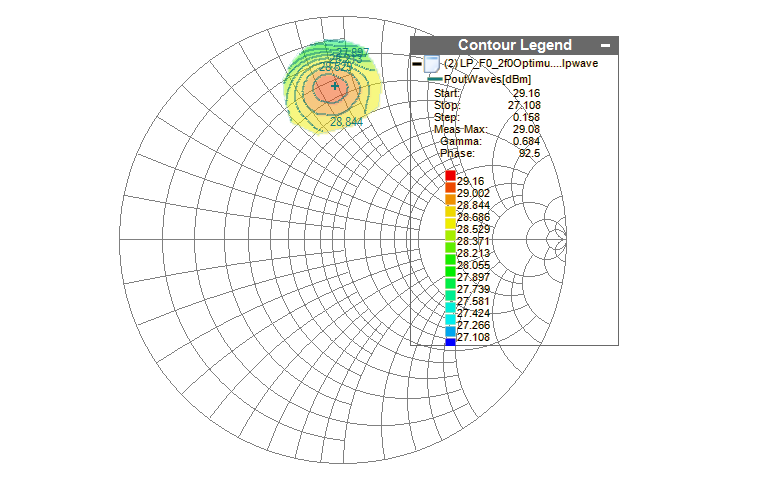Focus Microwaves - Vector Load Pull Test Software
Scalar Load Pull
This is a classic form of loadpull where a pre-calibrated source and load tuners are connected directly at the input and output of the device. The precise moment of the pre-calibrated tuners allows generation of complex reflection factors in highly repeatable manner.
Power meters at the input of the source and output of the load tuners are connected through couplers to search for the optimal gain and output power by synthesizing the source and load impedence using the pre-calibrated tuners. The optimum load impedence extracted is the complex reflection factor where maximum output power is measured using the maximum power transfer theorem. Similarly, at the input side the optimum source impedence is the point where maximum transduces gain is measured. The optimum load and source impedence are completely dependent upon the pre-calibrated tuners repeatability.
Setup
The typical scalar load pull setup comprises a signal generator, two RF power sensors, a power meter, some DC bias networks and two fundamental tuners. The input and output passive block comprising of couplers, bias tees are also pre-calibrated, and S-Par are defined in the measurement setup.
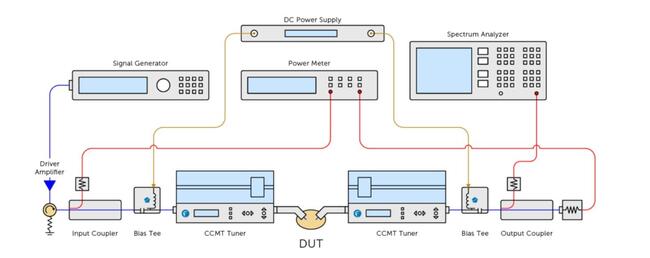
Parameters
The parameters measured using the scalar loadpull setup are:
- ΓLoad, Γsource
- All spectral quantities like ACPR, EVM and Harmonic Power levels are measured by connecting a Spectrum Analyzer at the output.
-

Vector Load Pull
More advanced loadpull setup is referred as Vector loadpull or VNA assisted loadpull. In this measurement setup the forward (a1,b1) and reverse (a2,b2) travelling waves are measured using the two directional couplers connected at the input and output of the DUT. Measuring “a” and “b” waves forms allows vector loadpull to calculate the real time tuner impedence presented to the DUT and does not fully rely on tuner calibration and repeatability. However, tuner calibration is useful to be able to steer tuning into right area of the smith chart without long search.
The typical vector loadpull comprises of two directional couplers, source and load tuners and the Vector Network Analyzer with receiver access capability. An absolute calibration at DUT reference plane is required to fully compute the 8-term error model, without leaving composite terms, as is the case for a standard small signal calibration.
Setup
A vector Loadpull setup can be upgraded to hybrid Active Loadpull and time domain measurements using the relevant hardware.
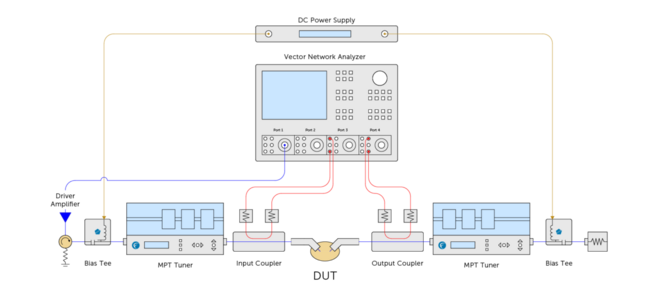
Parameters
The measured RF parameters include:
- PAE, ACPR
- ΓLoad, ΓIN
In this measurement setup both Power In delivered to the DUT and the PAE are calculated using the captured waveforms. All RF parameters are captured in a single shot which dramatically increases the measurement speed. All harmonic power levels are also measured by the Vector receiver.
Pulsed Load Pull
For high power non-linear devices, the self-heating and memory effects severely affect the performance when excited in the continuous wave mode. Using pulsed stimulus signals, the device can be characterized at the higher peak power levels up to saturation to which the devices will be subjected in their intended use. If the devices are excited in pulsed mode, they can be operated at higher peak power level at a reduced risk of device breakdown and a better control of operating temperature. In many applications Pulsed approach represents a realistic operation for devices, like RADARs.
Another important application of pulsed measurements is pulsed I-V and pulsed S-parameter. This approach has been widely used to extract electro thermal models of different device technology. Pulsed operation when combined with high DC voltage levels can also be very interesting for the validation of nonlinear models which considers thermal and trapping effects and can be used to test large devices that could not be tested at the same power levels under CW conditions due to excessive self-heating.
In Pulsed LP measurements both DC and RF can be pulsed. A pulsed load-pull test bench comprises of pulsed bias tees, a primary DC pulse generator, RF source synchronized to a pulse generator, and digitizing scope. The digitizing scope is used to monitor the Pulsed DC characteristics within the pulse. Focus LP uses two different options for Pulse generators, AU5 or MPIV. All passive components of the test setup (including the programmable tuners) are wideband enough to let the pulsed signal pass without any distortion.
For RF characterization there are two different scenarios
1. Scalar LP
Peak power meters synchronized to primary pulsing instrument are used to monitor the RF power within the pulses.
2. Vector LP
Measurements are made using the Vector Network Analyzer receivers which are synchronized with the primary pulsing instrument.
Setup
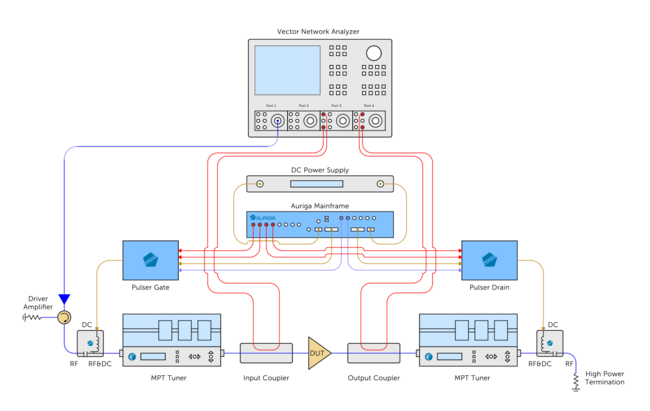
Paramters
The measured RF parameters include:
- PAE, ACPR
- ΓLoad, ΓIN
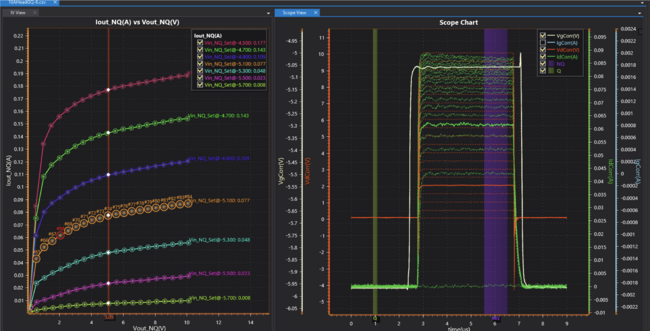
Active Load Pull
Active load pull tuning is, because of limited tuning range of passive tuners, additionally reduced by fixture and probe insertion loss, the only method allowing test engineers to reach up to |Γload|=1 (RDUT=0Ω) to match any DUT at its reference plane. In closed loop active tuning, part of the extracted RF power from the DUT is amplified and fed back into the DUT output port, creating a virtual load. Since the re-injected power can be higher than the original extracted power, Γ can be >1, meaning that insertion loss can be compensated. Using two (or more) synchronized (coherent) sources allows open-loop active (and harmonic) tuning; in fact the loop here is also closed, but, instead at RF, it is closed at IF synchronizing reference.
Setup
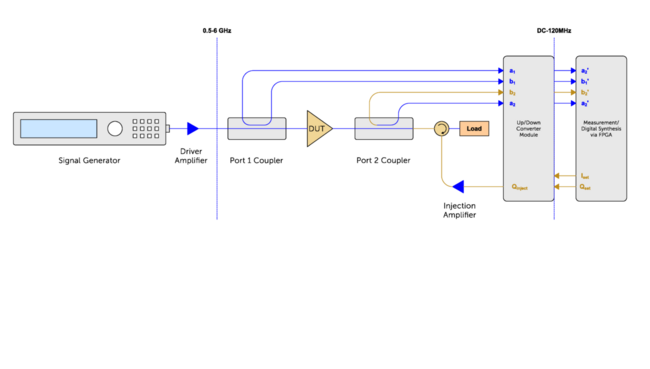
Parameters
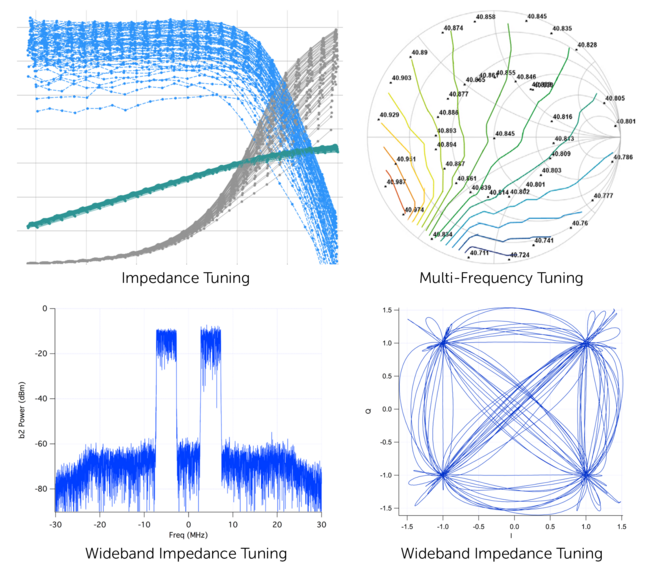
Modulated
WideBand Impedance Tuning
As communication standards require more and more channel bandwidth the need for wideband tuning is increasing. Wideband impedance tuning is now possible as RAPID’s active loop has 100MHz of instantaneous bandwidth allowing users to perform real time modulated measurements. Many spectrum analysis features are also available, such as ACPR, EVM, CCDF, Spectrum mask for advanced modulation standards like LTE and 802.11a/b/g/n/ac.
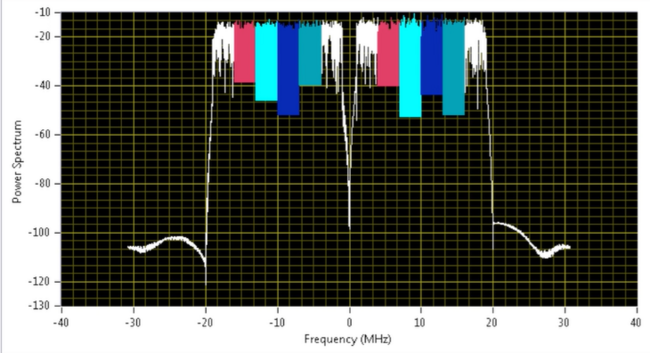
Active Hybrid Load Pull
Vector receiver based loadpull setup can be upgraded to a hybrid setup. As per its name a hybrid load pull system includes both an active loop as well as the passive tuners. The hybrid system has all the advantages of speed and tuning range of an active system as well as the power handling of a passive system.
Mechanical tuners due to their inherent passive nature have limitations in terms of impedence synthesis for devices with very low impedence, meaning realization of impedence at the edge of the smith chart. These limitations add up when any loss between tuner and DUT reference plane is introduces as in case of On-wafer vector loadpull where a coupler and RF probes are added between the tuner and DUT reference.
The principle of operation for hybrid LP is that the passive wideband (fundamental) tuner creates a reflection factor near the optimum load impedance (which cannot be reached using the passive tuner alone) and the active power injection creates the additional reflection factor needed to reach the border of the Smith chart (Γ=1). Because the mismatch conditions are better, the required power to be injected is, typically, lower than in the case of full Active LP.
Setup
To increase the reflection factor at the probe tip (DUT) and minimize the power loss we must maximize S21 and minimize S11. Any mismatch loss must be compensated by additional injected power in a hybrid (active/passive) tuner.
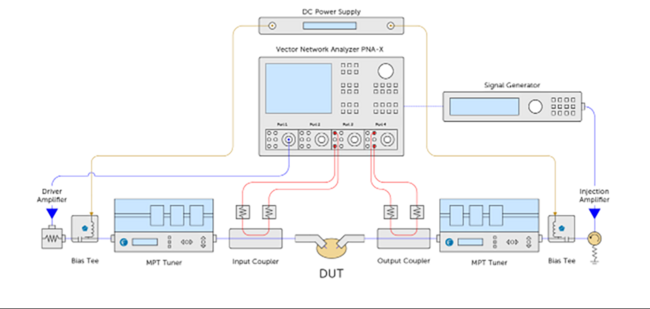
Parameters
Hybrid tuning is not a panacea. Whereas it allows high VSWR at DUT reference plane, it still remains a rather complex test system with feedback power amplifiers and, often, a second, synchronized, signal source, plus the requirement for in-situ vector power wave measurement, possible through directional couplers inserted between the DUT and the tuner; this on the other hand reduces the tuning range and increases the need for even higher power amplifiers. Passive pre-matching tuning in hybrid systems reduces the requirement for high power from the feedback amplifiers, but only to some extent: passive tuners are not lossless. Tuner loss increases rapidly with reflection factor and so does the power requirement. The critical quantity in tuner loss calculations is “mismatch loss”.
Mismatch loss is S212/(1-S112)
For high S11 values, as needed to pre-match for enhancing the passive reflection factor with active injection in a hybrid configuration, it happens that any increase in insertion loss S21 (due to cables, adapters etc. between tuner and DUT) is multiplied by a factor M=1/(1-S112).
Typical values of the multiplication factor:
S11=0.9 (VSWR=19:1) -> M=5.3
S11=0.96 (VSWR=50:1) -> M=13
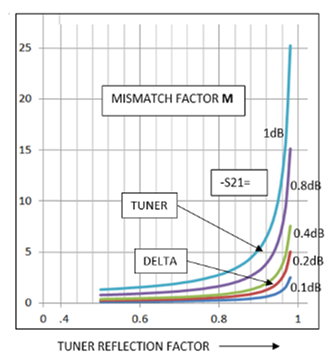
Time-Domain Load Pull
The Vector loadpull setup can be extended to fully calibrated time domain measurements by adding a phase reference. A phase reference is a device that has been pre-characterized to uncover the phase relationships between the fundamental and harmonic frequencies.
Time domain characterization technique is aimed at high power, non-linear devices that allows insight in process characteristics, comparisons to knee and breakdown voltages, and to have the ability to place the device into a known class of operation and view the resultant waveform. The shaping of current and voltage waveforms real time in the measurement cycle by accurately terminating the fundamental and harmonic frequencies enables the designer to choose the correct PA mode of operation and how to achieve it.
Setup
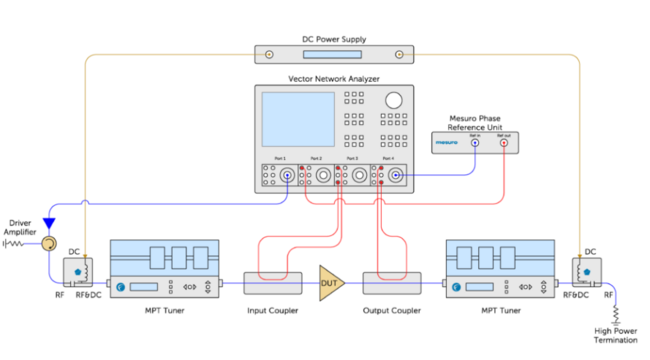
Parameters
First step in time domain measurement characterization is the standard small signal calibration, based on established techniques e.g. TRL which are Ratio measurements which ends up with composite error terms. The absolute calibration involves reference to known standards in terms of power and phase. Absolute power calibration is achieved with a calibrated power meter. For relative phase (time) a pre-calibrated phase reference HPR is used.
The measured RF parameters include:
- PAE, ACPR
- ΓLoad, ΓIN
- Loadlines
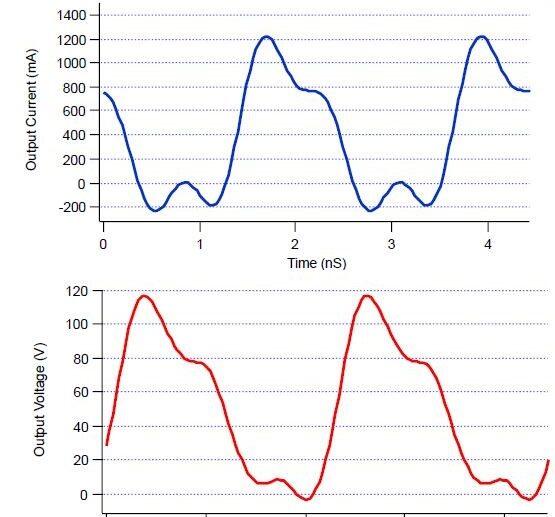
More Product Information
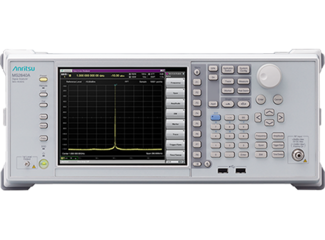
- Frequency range of 9 kHz to 3.6 GHz/6 GHz/26.5 GHz/44.5 GHz; 44.5 GHz max. built-in preamp option
- Best close-in phase noise performance in middle range signal analyzer/spectrum analyzer:
- –123 dBc/Hz (at 1 GHz center frequency, 10 kHz offset frequency with all frequency models)
- –138 dBc/Hz (at 1 GHz center frequency, 10 kHz offset frequency with 3.6 GHz and 6 GHz models, meas.)
- –140 dBc/Hz (at 150 MHz center frequency, 10 kHz offset frequency with 3.6 GHz and 6 GHz models, meas.)
- 31.25 MHz analysis bandwidth (standard); 125 MHz max. (option)
- All-in-one solution with built-in signal generator option supports TRx tests (with 3.6 GHz and 6 GHz models)
- Measurement applications (options): Phase Noise Measurement, Noise Figure Measurement, Vector and Analog Modulation Analysis, BER Measurement, Pulse Radar Measurement Function
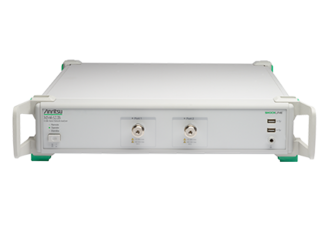
- Guaranteed performance to 43.5 GHz with Extended K™ ports
- Ideal for testing RF and microwave devices, mmWave antennas, and other passive 5G components
- Fast sweep speed and wide dynamic range minimize test times and maximize throughput
- Excellent corrected directivity allows for less measurement uncertainty
- Time domain with time gating option grants easier and faster fault identification
- Industry-standard LAN interface for remote control is more robust than USB and faster than GPIB
- Standard removable hard drive provides additional security for military and government research users
- A common GUI and SCPI interface within the ShockLine family
- USB ports allow for easy connection to user-provided monitor, keyboard, and mouse
- Small 2U package makes for efficient use of rack space
- Universal Fixture Extraction (UFX) software option provides advanced de-embedding tools for test fixture extraction
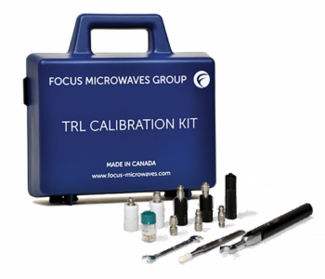
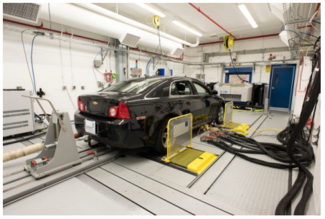
The automotive industry is a sector frequently on the cusp of transformation. Fast-paced industry shifts span technology innovations, regulatory standards, green initiatives, and customer expectations, influencing manufacturers’ testing needs, growth objectives, and overall business strategies. Companies striving for a competitive edge focus on sustainable practices, regulatory compliance, and innovation in Electric Vehicles (EVs), alternative fuels, and autonomous driving systems. This positions the automotive industry in vital need of testing facilities that are future-proofed for rapid and ongoing transformation.
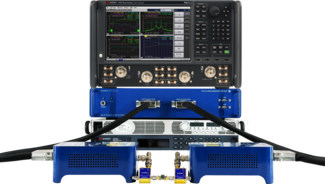
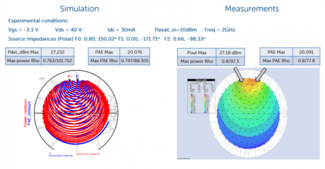
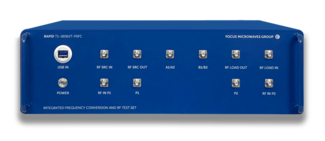
-
Supports the latest 5G FR1 and IEEE 802.11ax standards
-
up to 1GHz active load pull bandwidth capability
-
Test the latest high bandwidth and high modulation cellular standards such as 1024QAM 802.11ax
-
This system can be used in all parts of the design cycle
-
-
Initial device characterisation
-
MMIC or PA design
-
Design verification testing
-
Product testing in the factory
-
-
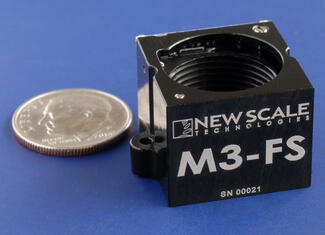
- Tiny “all-in-one” solution: no external control board needed
- Superior image quality: sub-micron lens movement with very low tilt. Now with higher dynamic stability
- Low voltage & power: 3.3 VDC input, zero power position hold
- Simple system integration: accepts high-level motion commands over standard serial interface (I2C or SPI)
- Flexible, production-ready system: compatible with M8 to M16 lenses and with typical image formats from 1/3” to 1/1.8”
- Lowest cost, fastest time to market: Fully-engineered “plug and play” solution

- Repair-focused environment for XJDeveloper / XJRunner tests.
- Full Connection test.
- RAM, Flash and other non-JTAG device tests.
- Flash, FPGA, CPLD and EEPROM programming.
- Layout Viewer* to show the physical location of faulty nets, pins and components.
- Schematic Viewer* to show the circuit design around faults.
- Direct control of the pins/balls of JTAG devices.
- View pin states graphically in real time or capture them in the Waveform Viewer.
- Trace signals to identify shorts, opens and other faults.

Focus Microwaves
Focus Microwaves is a pioneering engineering company, built around the innovations of its founder Dr. Christos Tsironis who developed his first manual tuner in 1973 and is the inventor of most existing electro-mechanical tuner families. The success of Focus is based on the engineering and manufacturing skills of its highly motivated and experienced team of engineers and technicians, who have been trained and encouraged to develop new technologies. In addition, listening to our customers needs and insights helps us discover and develop new and measurement methods on an ongoing basis, relentlessly pushing the limits of what is possible.
From humble beginnings in 1988, Focus has become the main supplier of advanced Load Pull and Noise Tuner Systems. Our mission is to provide effective, reliable and innovative solutions for non-50 Ohm testing (Noise and Load Pull) of RF microwave transistors, thus enabling our customers to compete in the marketplace with better designs and to advance the understanding and knowledge of the field.
Contact Details
Focus Microwaves Inc. Main Head Office
4555 Chem. du Bois-Franc, Saint-Laurent, QC H4S 1A8, Canada
Phone: +1-514-684-4554
Test & Measurement
